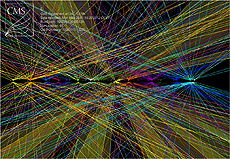Coping with high luminosity
 |
| A "Where's Waldo?" snapshot typifies the situation in a high-luminosity, high-interaction, environment. If these people arrived one at a time, were separated by larger distances or were more distinct, we could see them more easily. Similarly, scientists have to clarify the particle collision picture to cope with high luminosity.
|
After reading a recent Nutshell article about the Intensity Frontier, an inquisitive reader wanted to learn about how we cope with very bright beams. After all, the point of lots of luminosity is to make more collisions to find rare things, but lots of simultaneous collisions can make for a very confusing environment. This is an excellent question and there are many answers depending on context. Let's talk about some of them.
For some sorts of physics, the probability of an interaction is really, really small. This is the case with neutrino physics. Every two seconds, about ten trillion protons are extracted from the Fermilab accelerator and blasted into a target, making neutrinos. These neutrinos travel through the Earth to a distant detector, in which scientists observe a few neutrino interactions. To give a sense of scale, after about 1021 protons, the MINOS experiment has observed about 3,000 neutrinos in the far detector. In rough terms, that works out to about one observed neutrino interaction every eight to 24 hours. That's pretty straightforward to keep track of. Increasing the beam's intensity by a factor of ten means the time between neutrino interactions shrinks to something like an hour or so – still very easy to track. The slow rate doesn't tax the capabilities of the equipment at all. Thus, more intensity just shortens the length of time it takes to record enough data.
However, not all experiments have such a low interaction probability. In the LHC, collisions are far more frantic. At design luminosity we're talking about 20 interactions every time the beams cross. Since the beams will cross, or collide, about 40 million times a second when the machine is operating in its final configuration, we're talking about nearly a billion interactions per second. At that rate, the detector and electronics are barely coping. Scientists have to come up with some interesting tricks.
The first trick is called a trigger, a smart, automated way to select which of the tens of millions of beam crossings that occur every second are worth looking at. Not all physics collisions are of equal interest. Actually, most collisions are fairly uninteresting, low-energy collisions. The ones that might herald a discovery (or are at least probing rare physics) have unusual signatures. They could include highly energetic debris, particles that are somewhat rare, or a rare configuration or combination of particles. The LHC data acquisition system can record a few hundred events per second, or about one event for every 100,000 times the beams pass through one another. With triggering, we teach our electronics and computers to recognize the interesting configurations at superhuman speeds. By rejecting uninteresting events and concentrating on the rare, we enhance our chances of observing something that will improve our understanding of the universe.
 |
| This figure is a side view of the center of CERN's CMS detector immediately after two beams passed through one another. Our best estimate is that 50 independent collisions occurred simultaneously. This figure gives an idea of the challenges that come with increasing the luminosity of our beams.
|
Just as very few beam crossings are interesting, very few interactions in those beam crossings are interesting. You may have noted two paragraphs above that I blithely said there about 20 interactions every time the beams cross. When a detector records one interesting interaction, it simultaneously records on average 19 uninteresting ones, much as an ordinary photograph of a good friend might include pictures of others in the crowd. Again, we have to come up with ways to deal with the information that obscures the interesting events.
We have a few techniques for handling this situation. The first is to change how the beams arrive in the detector. Currently, the LHC is operating with collisions 20 million times a second. With some additional work, it will be possible to operate with collisions at 40 million times a second. But that doesn't mean we double the amount of beam in the accelerator. Instead, we'll keep the same amount of beam, thus halving the number of interactions that occur every crossing. This greatly simplifies how we reconstruct the interactions in an event.
In addition to reducing the number of interactions at each beam crossing, we make detectors with tiny pieces. If the pieces are large, it is possible that two or more particle will cross that particular piece at the same time. By increasing the number of pieces, it's more likely that each piece will have but one particle crossing it, so giving us a cleaner picture of the interaction.
We also add to our electronics the ability to measure the time that a particle crosses the tiny detector piece. At high energy, particles travel near the speed of light, about a foot per billionth of a second. Even with particles moving at that speed, modern detectors are big enough – a couple dozen feet in diameter – to capture them. If a beam crossing yields two interesting interactions at different spots in the detector, they'll emit particles that hit a detector piece several billionths of a second apart. We can use the timing information to tell which interaction is which.
So we see that in many cases, not only does extra luminosity bring new capabilities, it also brings many complex challenges. By separating events in time and building more finely grained detectors, we can fully exploit the benefits of the higher luminosity. For some topics, like neutrino studies, the extra luminosity brings more data, with only a minimum of headaches.
In any case, more data, cleverly studied, is always a good thing.
Want a phrase defined? Have a question? Email today@fnal.gov.
—Don Lincoln
|